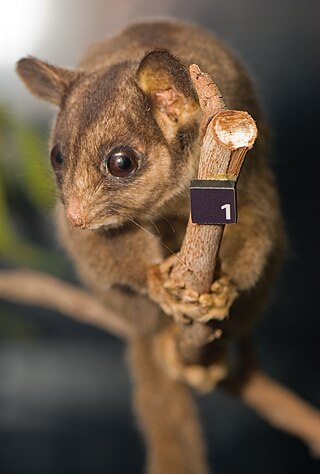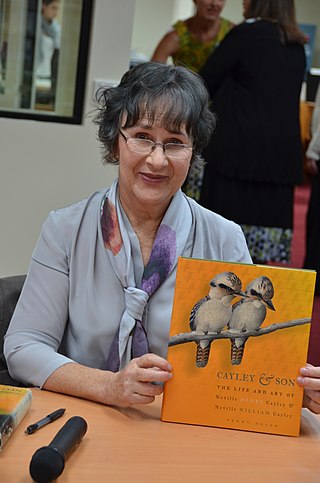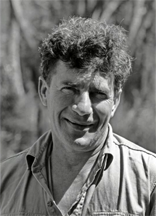Related Research Articles

Yarra Ranges National Park is located in the Central Highlands of Australia's southeastern state Victoria, 107 km northeast of Melbourne. Established in 1995 and managed by the statutory authority Parks Victoria, the park features a carbon-rich, temperate rainforest and a subalpine eucalypt forest on its northern plateau. It is home to large stands of mountain ash, the tallest tree species in Australia and among the tallest in the world. A wide diversity of fauna make their home across the park's 76,003 hectares, including kangaroos, wallabies, wombats, platypuses and 120 species of native birds. Among the conservation challenges facing Yarra Ranges National Park are climate change and invasive species of weeds.

Leadbeater's possum is a critically endangered possum largely restricted to small pockets of alpine ash, mountain ash, and snow gum forests in the Central Highlands of Victoria, Australia, north-east of Melbourne. It is primitive, relict, and non-gliding, and, as the only species in the petaurid genus Gymnobelideus, represents an ancestral form. Formerly, Leadbeater's possums were moderately common within the very small areas they inhabited; their requirement for year-round food supplies and tree-holes to take refuge in during the day restricts them to mixed-age wet sclerophyll forest with a dense mid-story of Acacia. The species was named in 1867 after John Leadbeater, the then taxidermist at the Museum Victoria. They also go by the common name of fairy possum. On 2 March 1971, the State of Victoria made the Leadbeater's possum its faunal emblem.

The regent honeyeater is a critically endangered bird endemic to southeastern Australia. It is commonly considered a flagship species within its range, with the efforts going into its conservation having positive effects on many other species that share its habitat. Recent genetic research suggests it is closely related to the wattlebirds.

The squirrel glider is a nocturnal gliding possum. The squirrel glider is one of the wrist-winged gliders of the genus Petaurus.

The glossy black cockatoo, is the smallest member of the subfamily Calyptorhynchinae found in eastern Australia. Adult glossy black cockatoos may reach 50 cm (19.5 in) in length. They are sexually dimorphic. Males are blackish brown, except for their prominent red tail bands; the females are dark brownish with some yellow spotting. Three subspecies are recognised.
Michael Brooker is an Australian ornithologist based in Western Australia following retirement from a career with the CSIRO's Division of Wildlife Research. There he worked on wedge-tailed eagles, fauna surveys, the environmental impact of wildfire and the conservation value of remnant patches of native vegetation. Since then he has collaborated with his wife Lesley Brooker in studies on cuckoo evolution, population ecology of fairy-wrens and spatial dynamics of birds in fragmented landscapes. In 2004 he was awarded, jointly with his wife Lesley, the Royal Australasian Ornithologists Union's D.L. Serventy Medal which recognizes excellence in published work on birds in the Australasian region.
Ian Cecil Robert Rowley was an Australian ornithologist of Scottish origin. He was born in Edinburgh and educated at Wellington College and Cambridge University. Following service in the Royal Navy during the second world war, he moved to Australia in 1949 and graduated in Agricultural Science from the University of Melbourne under the Commonwealth Reconstruction Training Scheme.

Penelope Diane Olsen is an Australian ornithologist and author. She has worked with CSIRO as an experimental officer and an Honorary Research Associate as well as being an ARC Postdoctoral Fellow at the Australian National University. She is also internationally recognised as an expert on raptors and was involved in the conservation work on Norfolk Island for the Norfolk Island Boobook. She was President of the Australasian Raptor Association 1984–1989. In 1997 she was awarded the Royal Australasian Ornithologists Union's D.L. Serventy Medal for excellence in published work on birds in the Australasian region. Olsen formerly edited Wingspan, an ornithology magazine published by Birds Australia.
James Allen Keast was an Australian ornithologist, and Professor of Biology at Queen's University, Kingston, Ontario, Canada. Born in Turramurra, New South Wales, he performed war service 1941–1945 in New Guinea and New Britain. He earned his BSc (1950) and MSc (1952) degrees at the University of Sydney, going on to earn an MA (1954) and PhD (1955) from Harvard. He started the first natural history series on Australian television in 1958–1960. A long-time member and benefactor of the Royal Australasian Ornithologists Union (RAOU), he was elected a Fellow of the RAOU in 1960. Keast joined the faculty of Queen's in 1962, and in 1989 became a professor emeritus. In 1995 he was awarded the D.L. Serventy Medal for outstanding published work on birds in the Australasian region. As well as numerous scientific papers, he authored and edited several books.

Vincent Noel Serventy AM was an Australian author, ornithologist and conservationist.

The yellow-bellied glider, also known as the fluffy glider, is an arboreal and nocturnal gliding possum that lives in native eucalypt forests in eastern Australia, from northern Queensland south to Victoria.

The Bramble Cay melomys, or Bramble Cay mosaic-tailed rat, is a recently extinct species of rodent in the family Muridae and subfamily Murinae. It was an endemic species of the isolated Bramble Cay, a low-lying vegetated coral cay with a habitable area of approximately 5 acres located at the northern tip of the Great Barrier Reef in Australia. Described by researchers as having last been seen in 2009 and declared extinct by the Queensland Government and University of Queensland researchers in 2016, it was formally declared extinct by the International Union for Conservation of Nature (IUCN) in May 2015 and the Australian government in February 2019. Having been the only mammal endemic to the reef, its extinction was described as the first extinction of a mammal species due to anthropogenic climate change.

The smoky mouse is a species of rodent in the family Muridae native to southeastern Australia. It was first described in 1934 and its species name is Latin for "smoky". As its name suggests, it is a grey-furred mouse, darker grey above and paler smoky grey below. Mice from the Grampians are larger and a darker more slate-grey above. It has a black eye-ring and dark grey muzzle. The feet are light pink, and the ears a grey-pink. The tail is longer than the mouse's body, and is pink with a brownish stripe along the top. Mice from east of Melbourne average around 35 grams and have 107 mm long bodies with 116 mm long tails, while those from the Grampians are around 65 grams and have 122 mm long bodies with 132 mm long tails.

The mallee emu-wren is a species of bird in the Australasian wren family, Maluridae. It is endemic to Australia.

The Australian Wildlife Conservancy (AWC) is an Australian independent, nonprofit organisation, working to conserve threatened wildlife and ecosystems in Australia. This is principally achieved through the acquisition of extensive areas of land on which to establish conservation reserves ("sanctuaries") or by entering into partnerships with government, Indigenous groups, and private landholders to manage landscapes for effective conservation. AWC is the largest private owner and manager of land for conservation in Australia, currently managing 31 sanctuaries and partnership sites for wildlife conservation that cover over 6.5 million hectares of land across Australia.

Established in 1965, the Yellingbo Nature Conservation Reserve is located 45 km east of Melbourne in the Upper Yarra Valley, near the towns of Yellingbo, Launching Place, Yarra Junction, Hoddles Creek, Cockatoo, Emerald, Monbulk and Seville. Yellingbo Nature Conservation Reserve is a narrow riparian reserve with stream-frontage land along the Woori Yallock, Shepherd, Cockatoo, Macclesfield and Sheep Station Creeks.


Distinguished Professor David Lindenmayer,, is an Australian scientist and academic. His research focuses on the adoption of nature conservation practices in agricultural production areas, developing ways to improve integration of native forest harvesting and biodiversity conservation, new approaches to enhance biodiversity conservation in plantations, and improved fire management practices in Australia. He specialises in large-scale, long-term research monitoring programs in south-eastern Australia, primarily in forests, reserves, national parks, plantations, and on farm land.

The northern masked owl is a large forest owl in the family Tytonidae. The northern kimberli subspecies was identified as a novel race of the Australian masked owl by the Australian ornithologist Gregory Macalister Mathews in his 1912 reference list of Australian birds. The northern masked owl occurs in forest and woodland habitats in northern Australia, ranging from the northern Kimberley region to the northern mainland area of the Northern Territory and the western Gulf of Carpentaria. While the Australian masked owl is recognized as the largest species in the family Tytonidae, the northern masked owl is one of the smallest of the Australian masked owl subspecies.
References
- ↑ https://birdlife.org.au/documents/AWR-serventy-medallists-1991-2020.pdf D.L. Serventy Medal: Citation | retrieved: 23 September 2020
- ↑ "Australian Commonwealth, Department of Agriculture Water and Environment, Wildlife and threatened species bushfire recovery Expert Panel". Archived from the original on 7 September 2020.
- ↑ Woinarski, John; Burbridge, Andrew; Harrison, Peter (June 2014). The Action Plan for Australian Mammals 2012 (PDF). CSIRO. ISBN 9780643108745.
- ↑ Purtill, James (20 February 2019). "An Australian rodent has become the first climate change mammal extinction". Triple J Hack. Australian Broadcasting Corporation. Retrieved 21 February 2019.
- ↑ "Australian Commonwealth, Department of Agriculture Water and Environment, Wildlife and threatened species bushfire recovery Expert Panel". Archived from the original on 7 September 2020.
- ↑ "Friends of Leadbeater's Possum Inc v VicForests (No 4) [2020] FCA 704". Federal Court of Australia. 27 May 2020. Retrieved 27 May 2020.